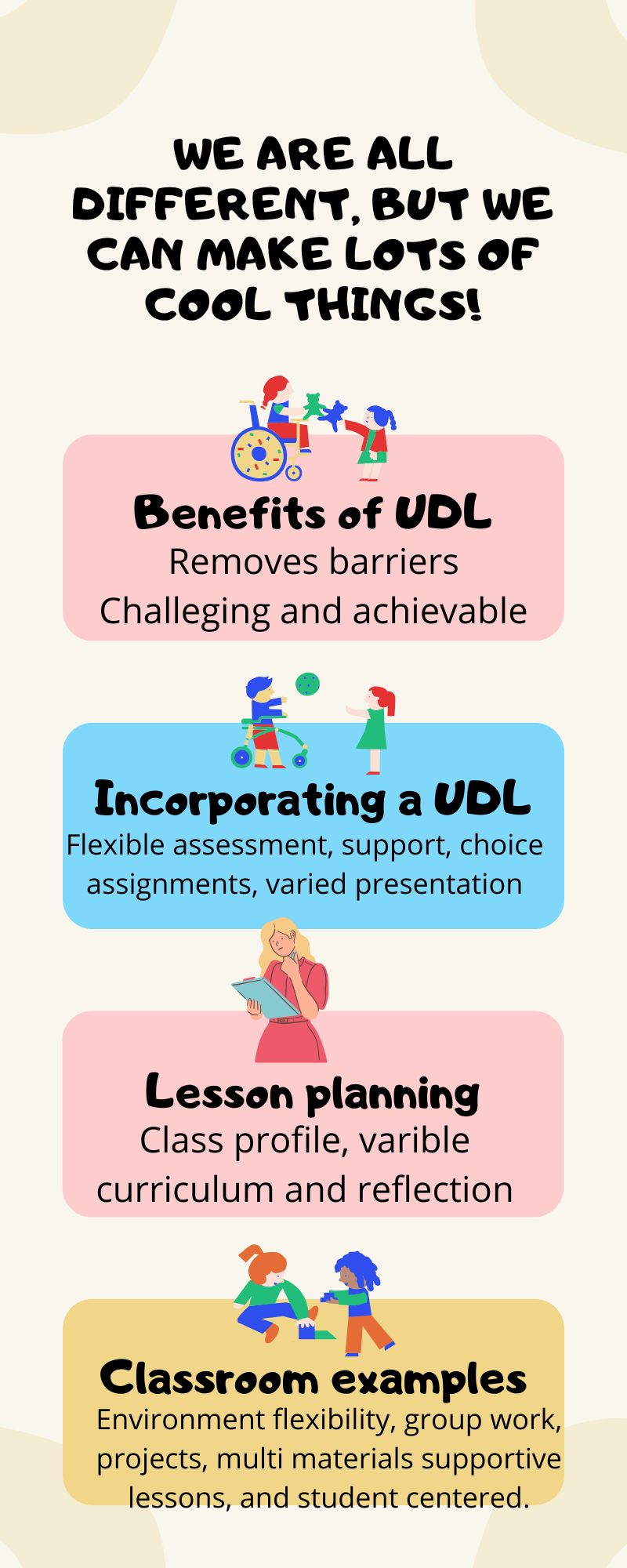Author:
UDL refers to universal design for learning, which provides an equal opportunity for all learners no matter what their cultural background, nationality, race, gender or personal healthy situations are, and it satisfies the needs of all learners (Arella, 2019).
As a learner, I benefited from UDL learning. In one class which I had before, there was a mother who attended the class with her child every class. And the professor just noticed the phenomenon. Therefore, every time the professor showed the students slides, videos and TED talk, she would always consider that the contents should be suitable for everyone, including this little kid who was only 6 years old. This experience gives me so much enlightenment and implications in my following study and thoughts on teaching.
In my future pathway to be a teacher, especially being a teacher in Canada where it consists of immigrants from other countries, it is vital to incorporate the UDL into my teaching. So how to incorporate UDL into my class? First, before class, it is better for me to learn the profiles of all students in my class, like what they like and dislike and with whom they learn better. In this way, when I give group work, I would know how to allocate the groups to foster them study in a comfortable and encouraging environment. Second, I think I will design multiple ways for them to express what they have learned. For example, if the students like poems, they are permitted to create a poem; if some students are good at music, they are permitted to initiate a music ban or a music rhythm.
In a word, in Canada where technology is in rapid development and immigrants from everywhere go to this country, it is meaningful to employ the UDL teaching in future classes.
Reference:
Frank Arella. (2019, December 18). Teachings in education, Universal design for learning: UDL [Video]. YouTube. https://www.youtube.com/watch?v=gmGgplQkrVw

Hi Sophia,
I smiled while reading your blog because I loved what the professor did to accommodate diverse learners, including a child. He made his class suitable for everyone. A lot of people have benefited from UDL, and as educators, we don’t just teach we can touch lives in the process.
I really like the plan you have for your future class. Getting to know each child’s likes, dislikes and how they learn best will definitely make a big difference because it will help them feel included and valued. When they find it difficult to understand a teacher’s approach, some children turn to their parents for help. However, a lot of parents work multiple jobs because of financial difficulties, which leaves them with little to no time to assist with assignments. Therefore, I believe your approach will go a long way.
Thank you, Sophia, for sharing your story. I am impressed by the personal example you mentioned in this article, where the professor adopted the class materials for a child; this illustrates the essence of UDL: making learning accessible for all learners. In UDL, teachers plan their lessons so that people with different needs, abilities, and backgrounds can all take part. That is exactly what your professor did. She didn’t just teach for adults- she made sure the child could learn, too.
I also like your ideas about using UDL in your future teaching. You mentioned being flexible and including everyone, which is a great plan. Giving students many ways to learn and show what they know will help each one succeed. It is clear that you want to make your classroom welcoming and inclusive for all students.
Overall, this is a thoughtful and insightful reflection, and your writing made me think more about how I can use UDL in my teaching. Thank you for sharing your experience and ideas.
You bring up some good questions about how to integrate UDL principles into your teaching. Getting to know your students is an excellent way to meet their needs. Also finding out what other teachers have done in the past with students with different needs. At times, it is difficult to accommodate all the diverse learners, but we can certainly do our best!